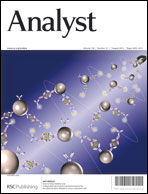Beyond the ridge pattern: multi-informative analysis of latent fingermarks by MALDImass spectrometry
Abstract
After over a century, fingerprints are still one of the most powerful means of biometric identification. The conventional forensic workflow for suspect identification consists of (i) recovering latent marks from crime scenes using the appropriate enhancement technique and (ii) obtaining an image of the mark to compare either against known suspect prints and/or to search in a Fingerprint Database. The suspect is identified through matching the ridge pattern and local characteristics of the ridge pattern (minutiae). However successful, there are a number of scenarios in which this process may fail; they include the recovery of partial, distorted or smudged marks, poor quality of the image resulting from inadequacy of the enhancement technique applied, extensive scarring/abrasion of the fingertips or absence of suspect's fingerprint records in the database. In all of these instances it would be very desirable to have a technology able to provide additional information from a fingermark exploiting its endogenous and exogenous chemical content. This opportunity could potentially provide new investigative leads, especially when the fingermark comparison and match process fails. We have demonstrated that


 Please wait while we load your content...
Please wait while we load your content...